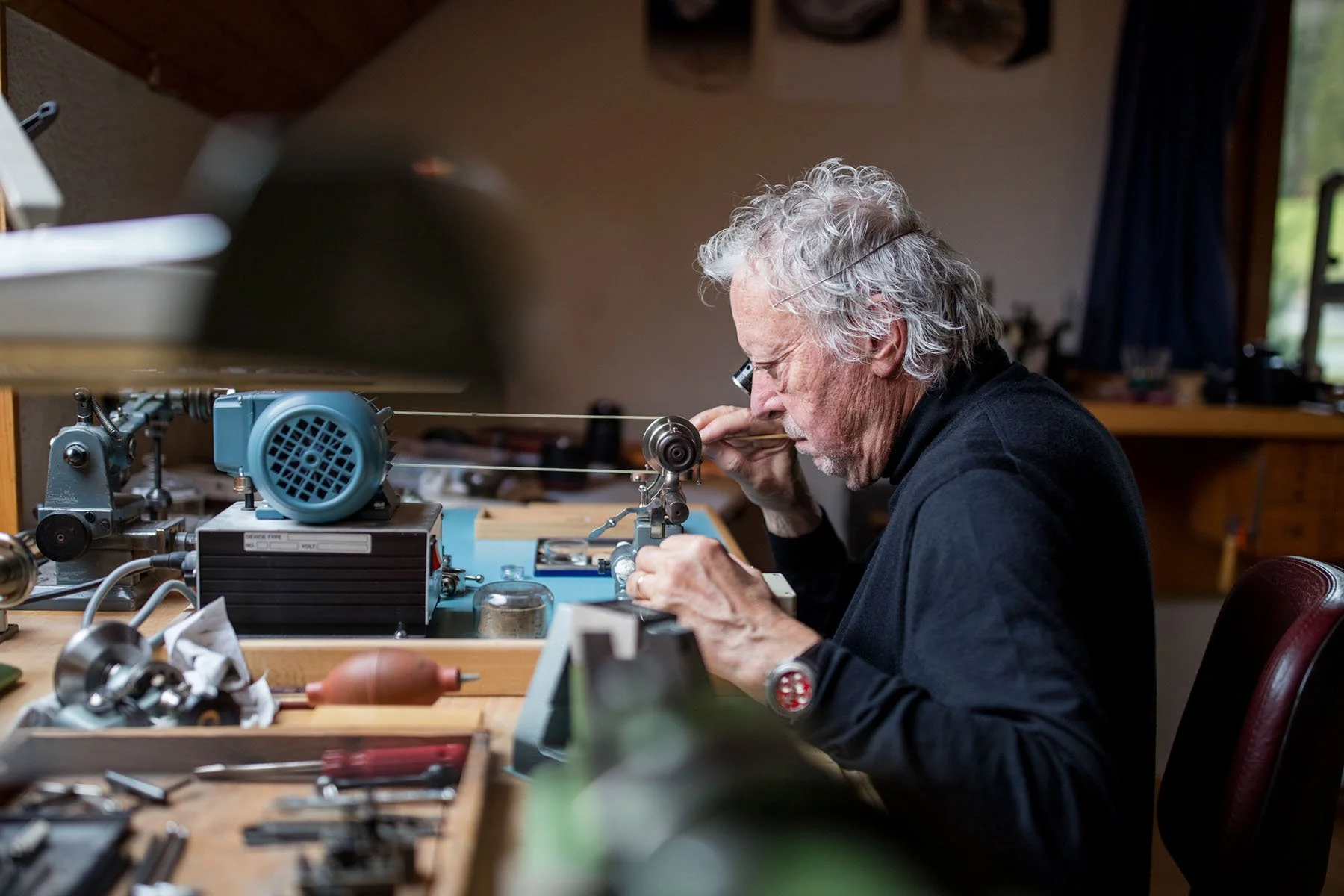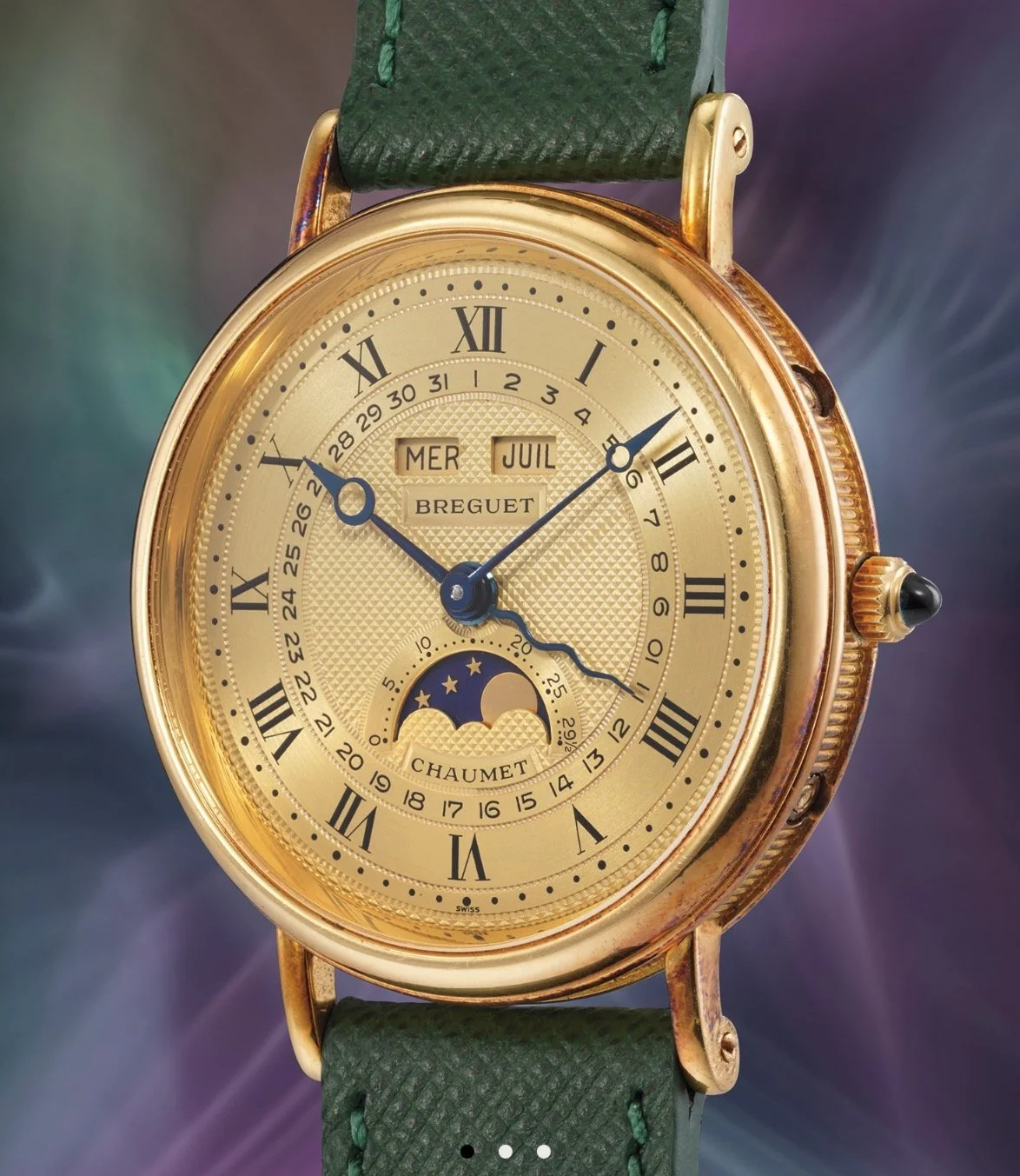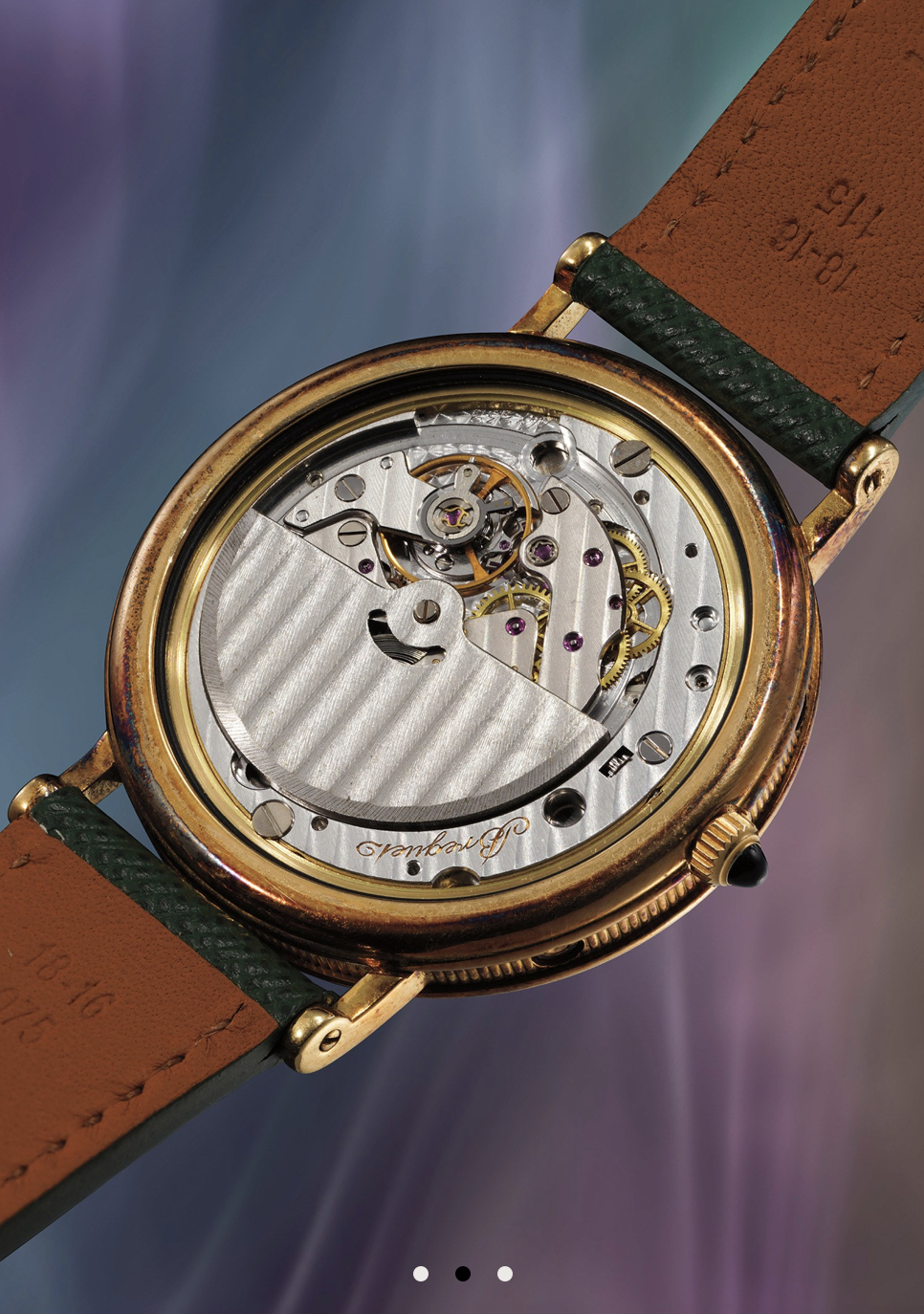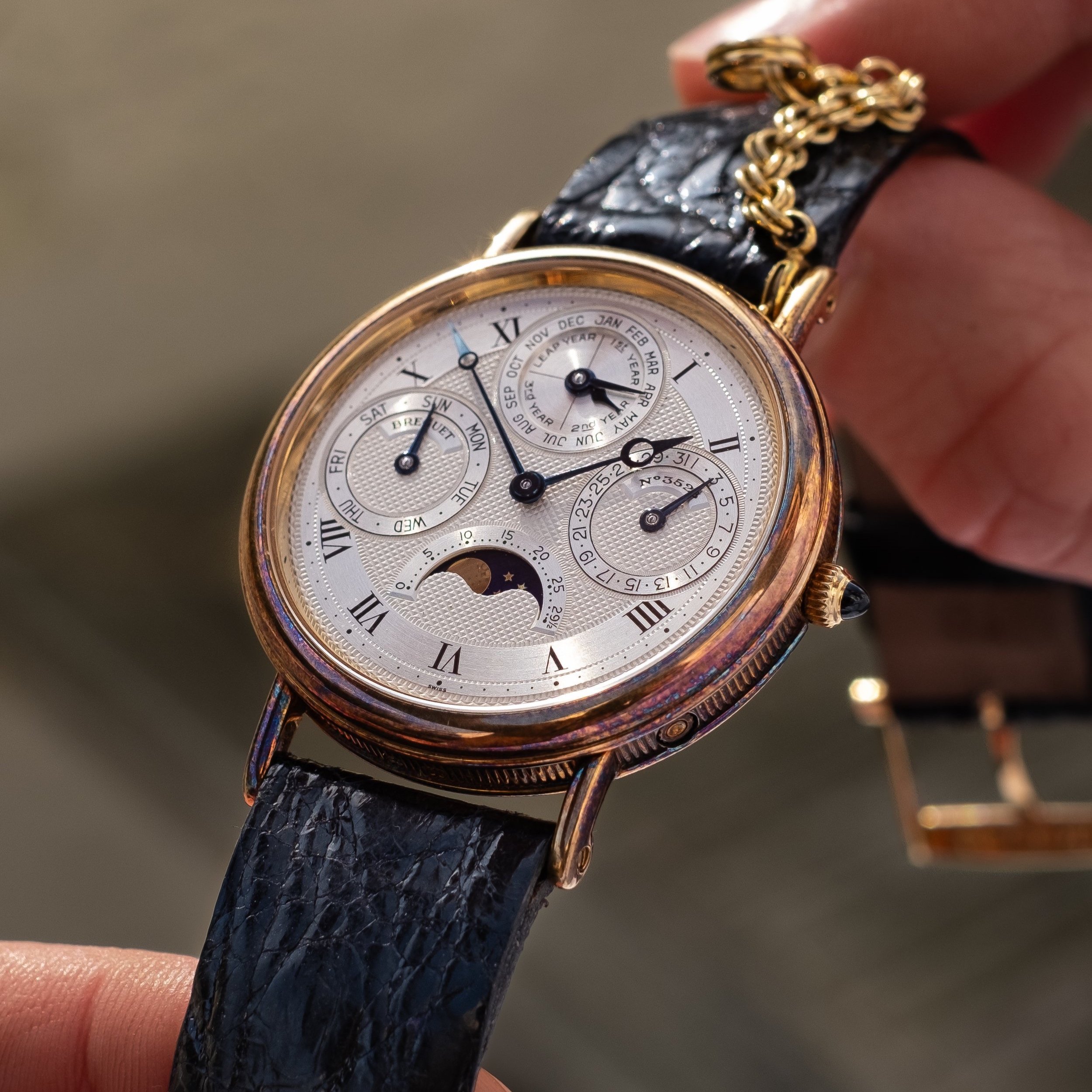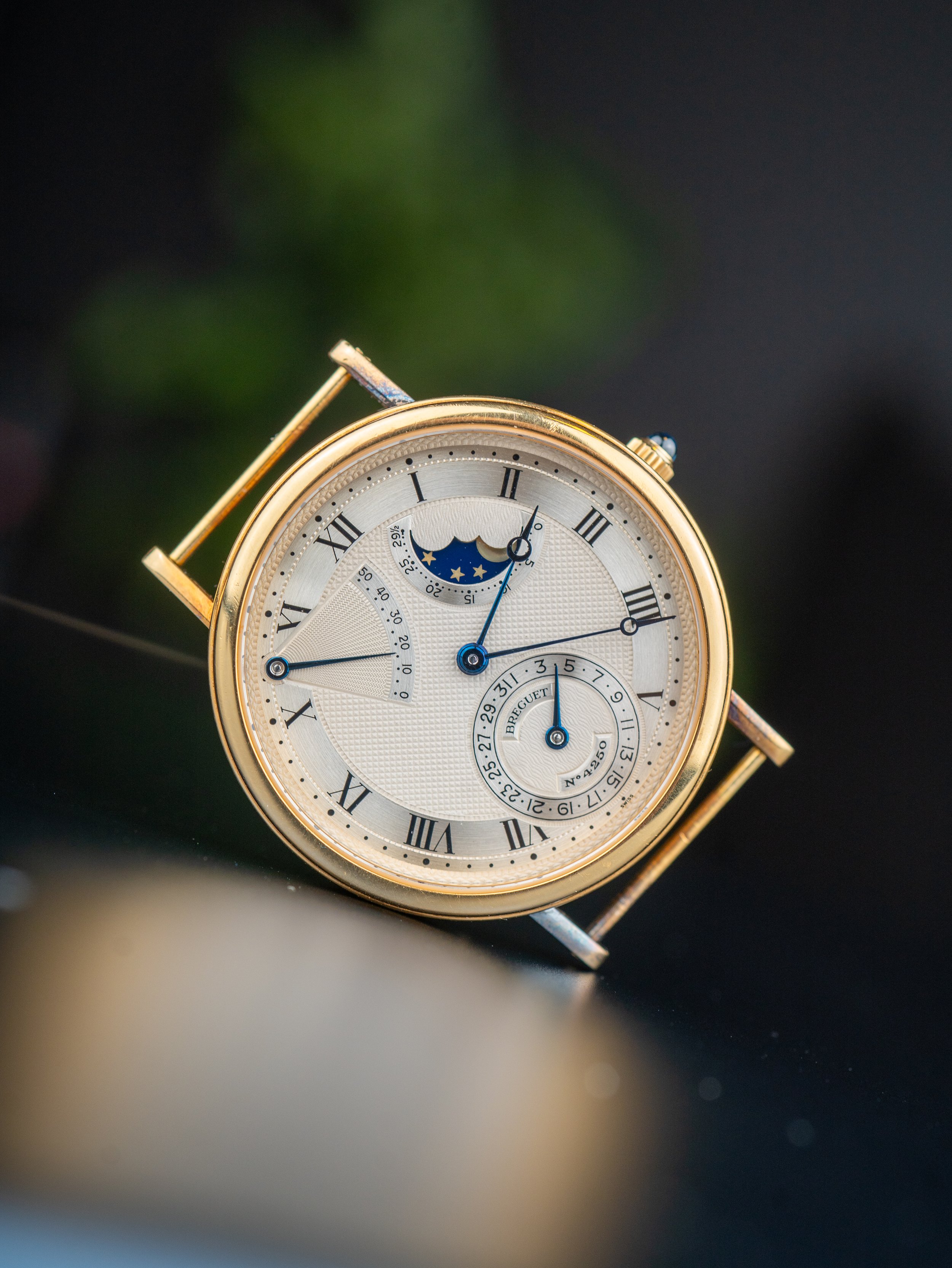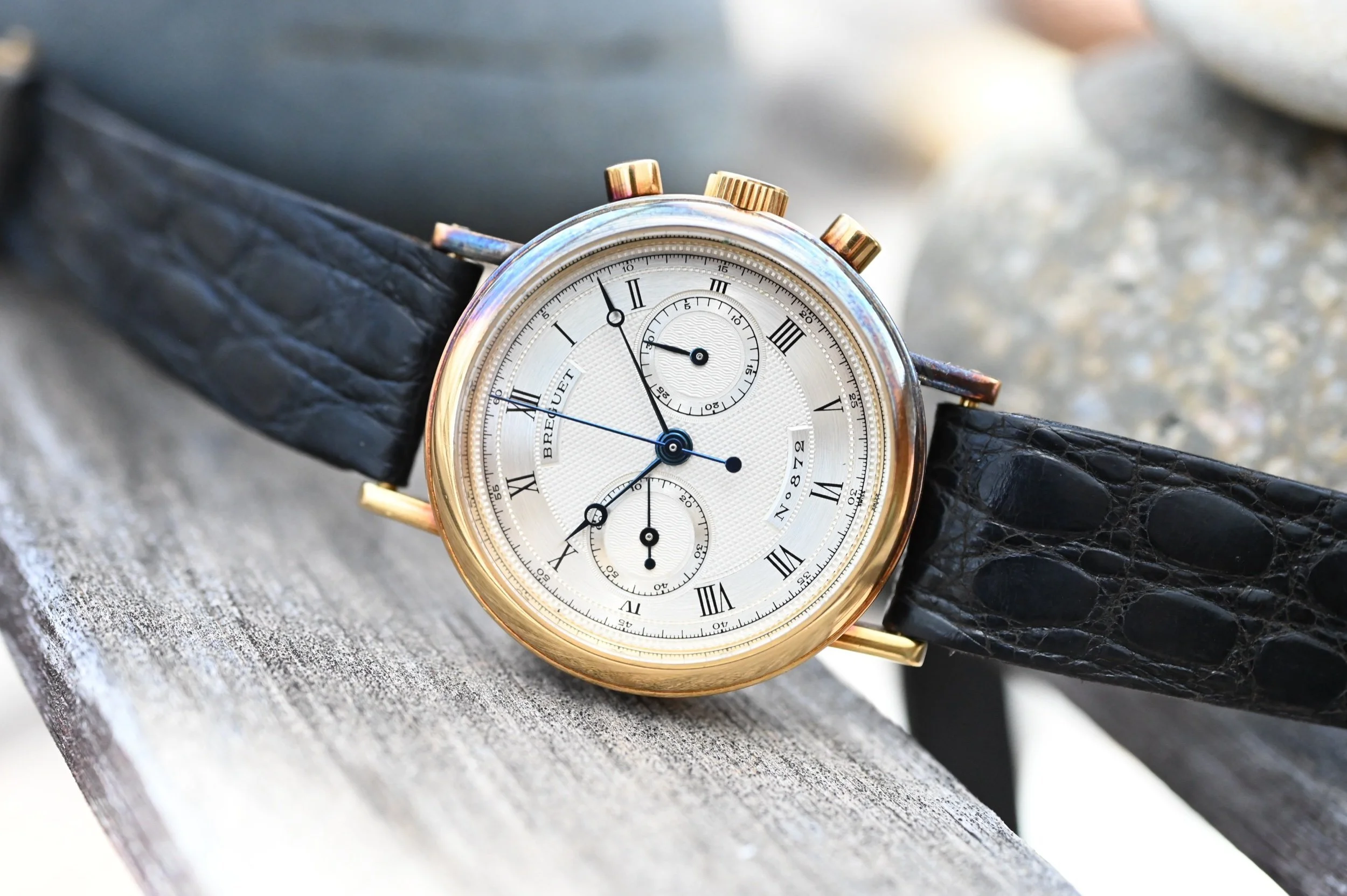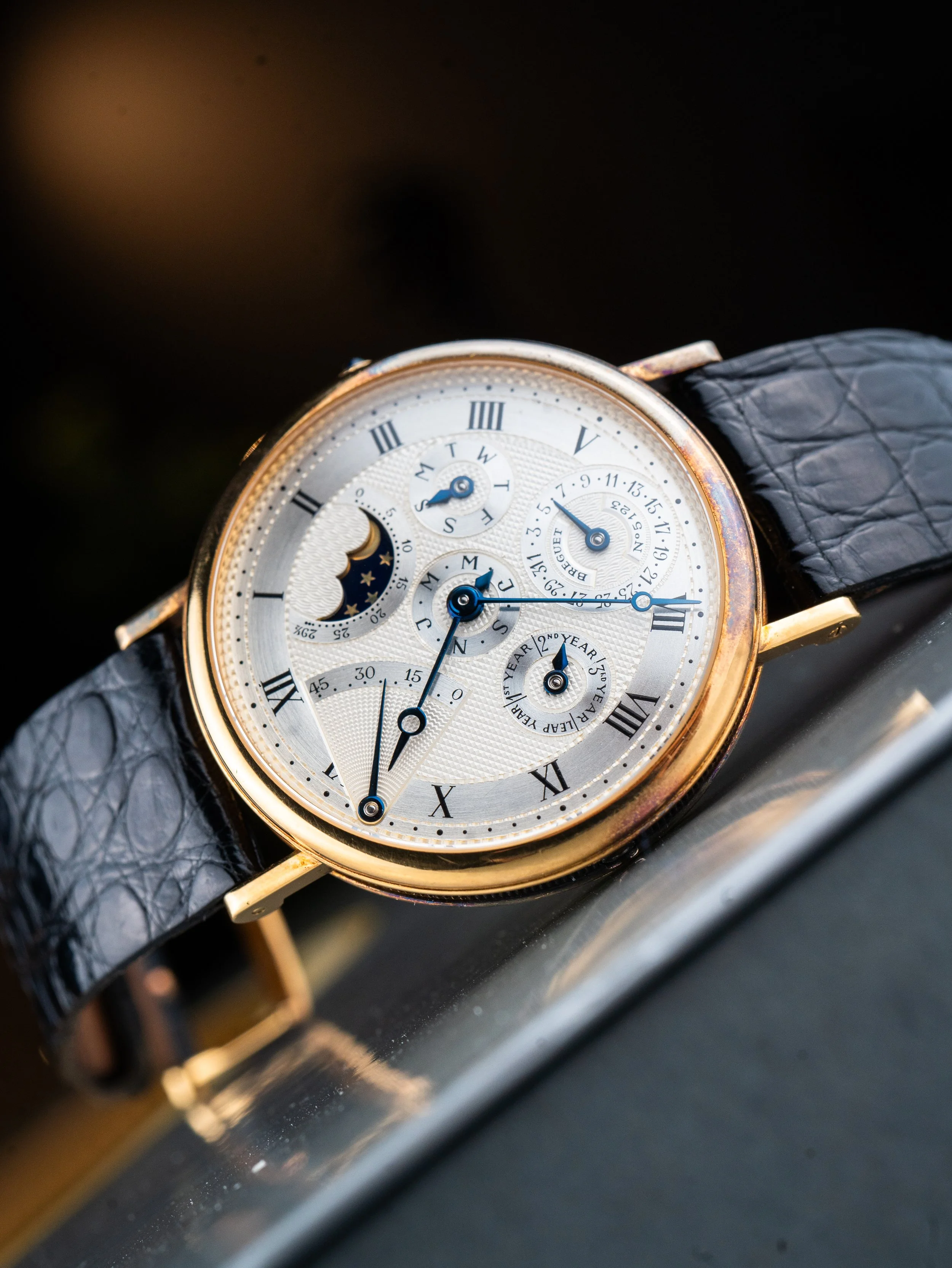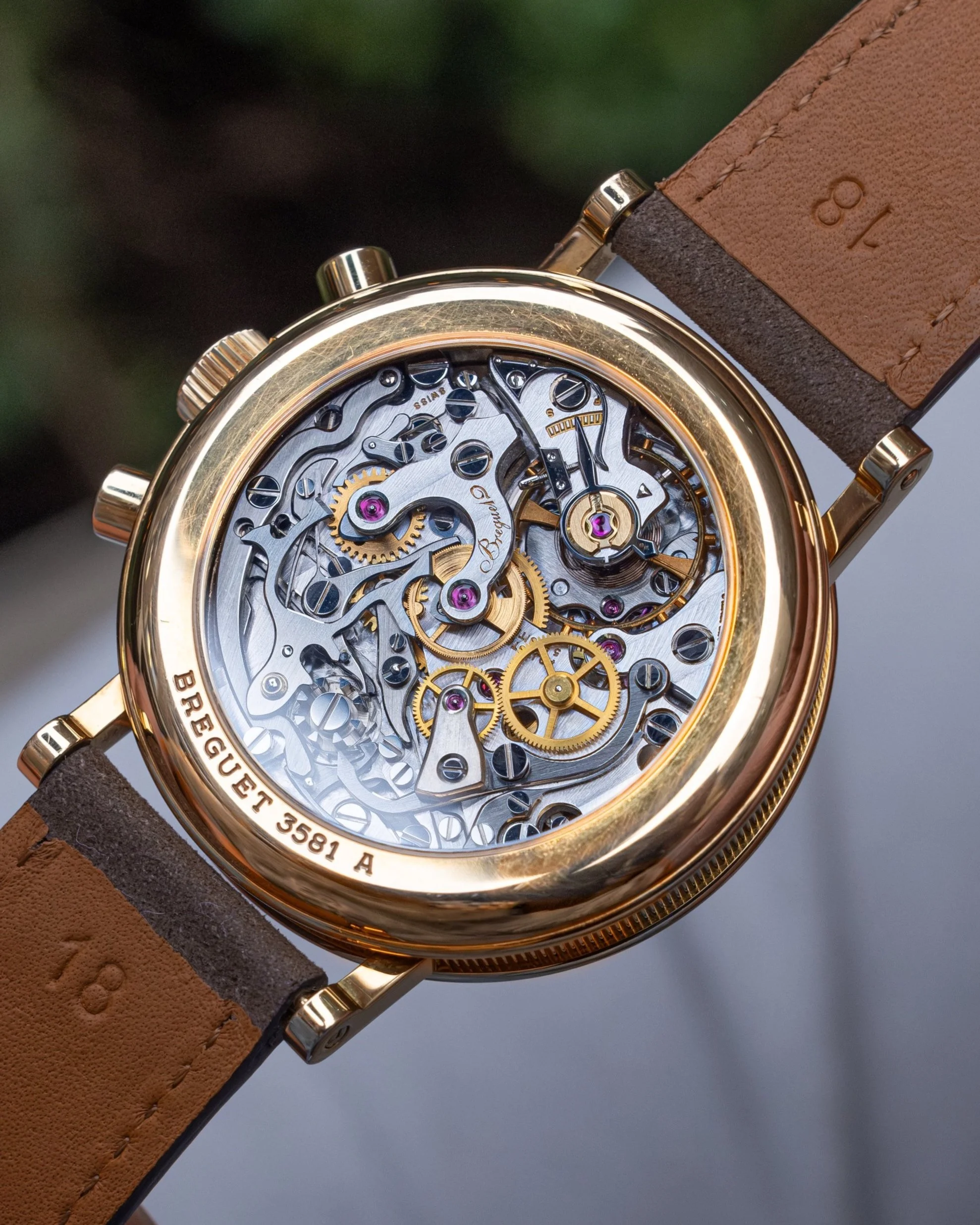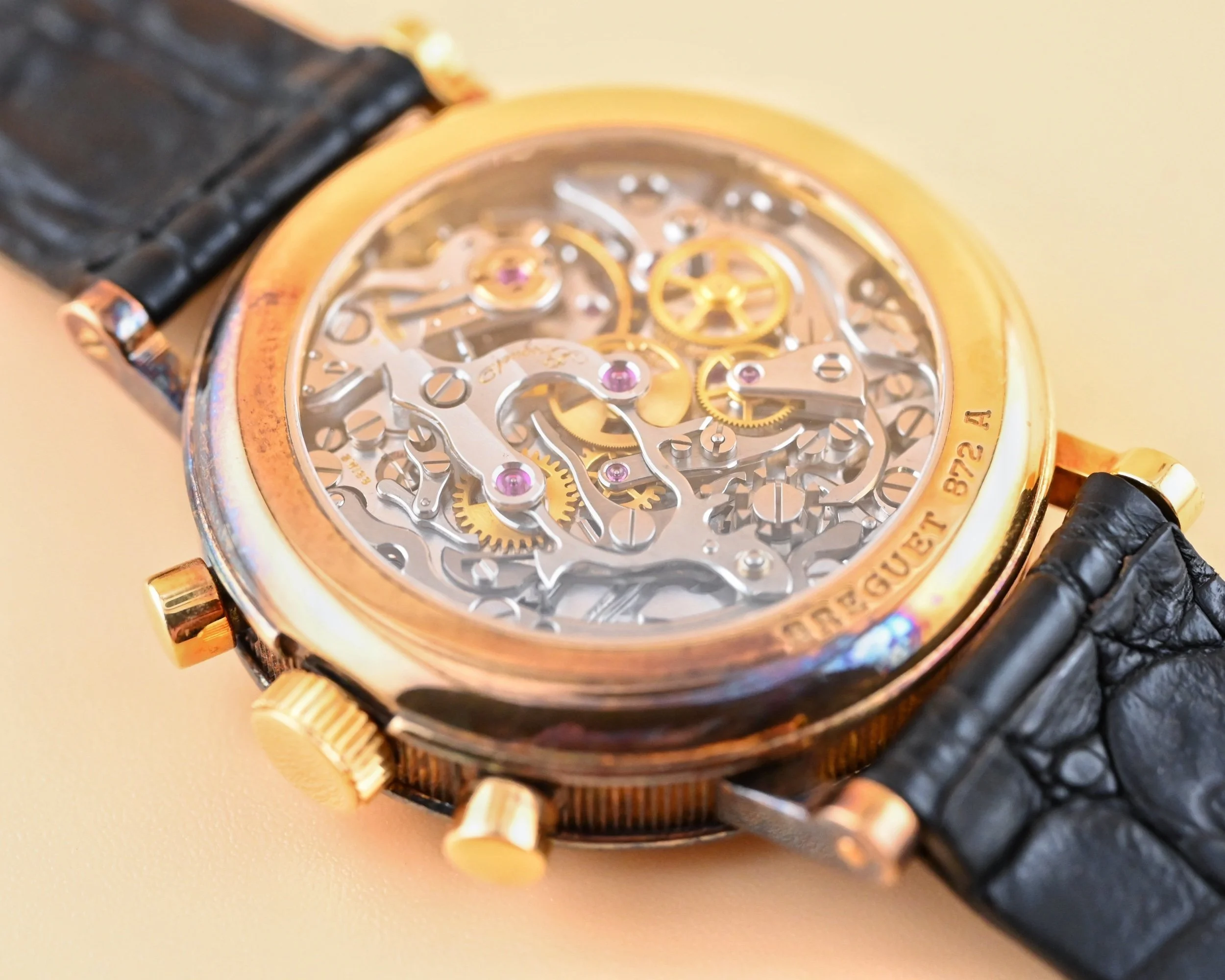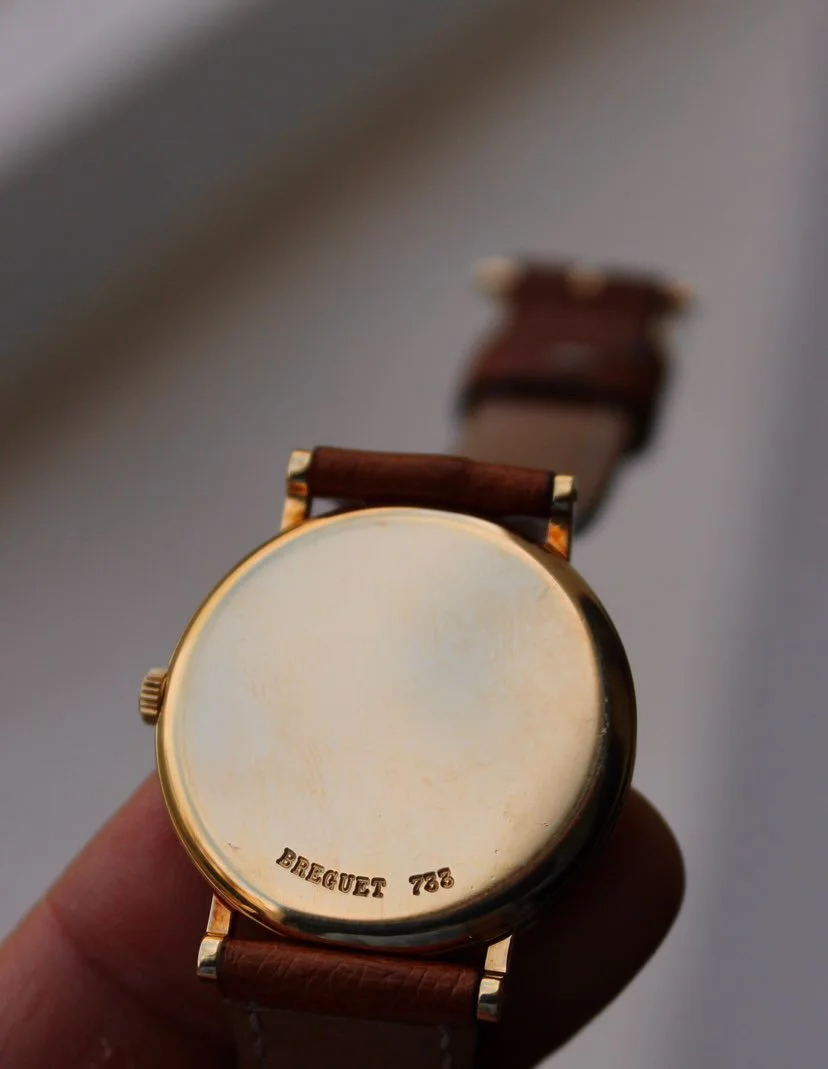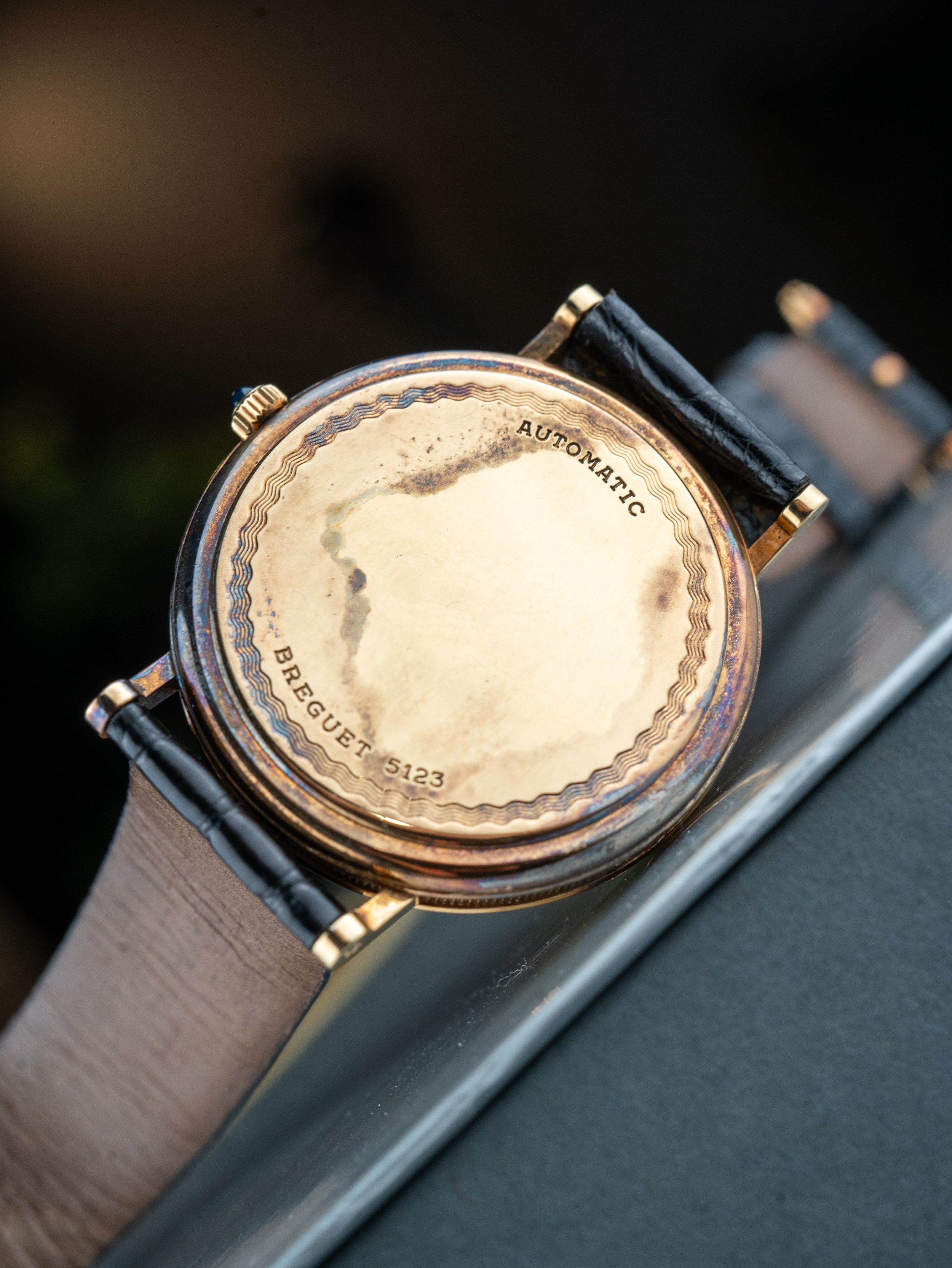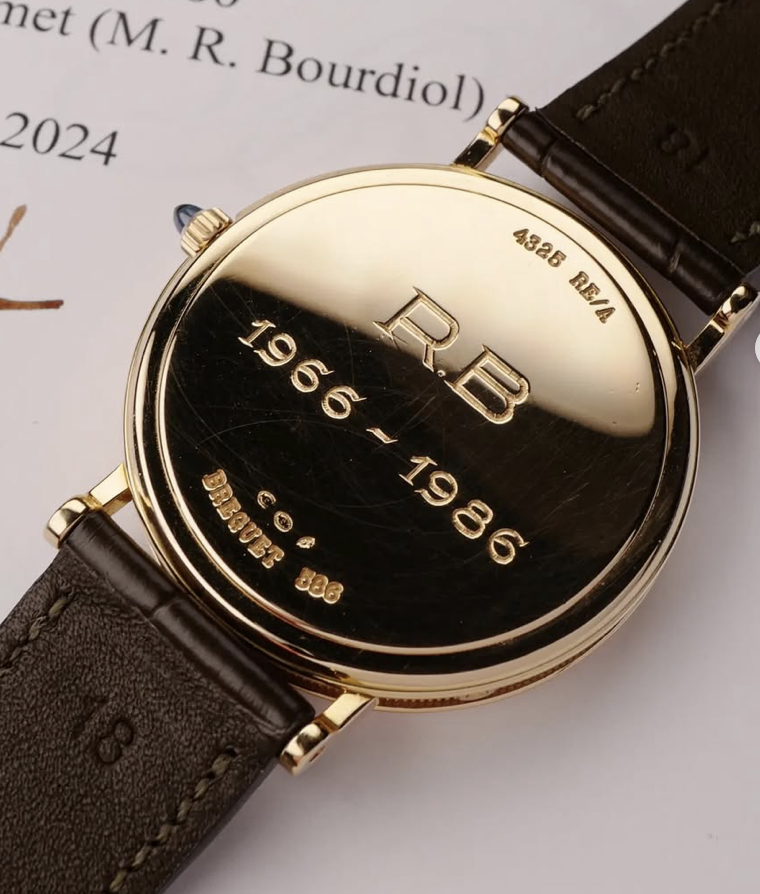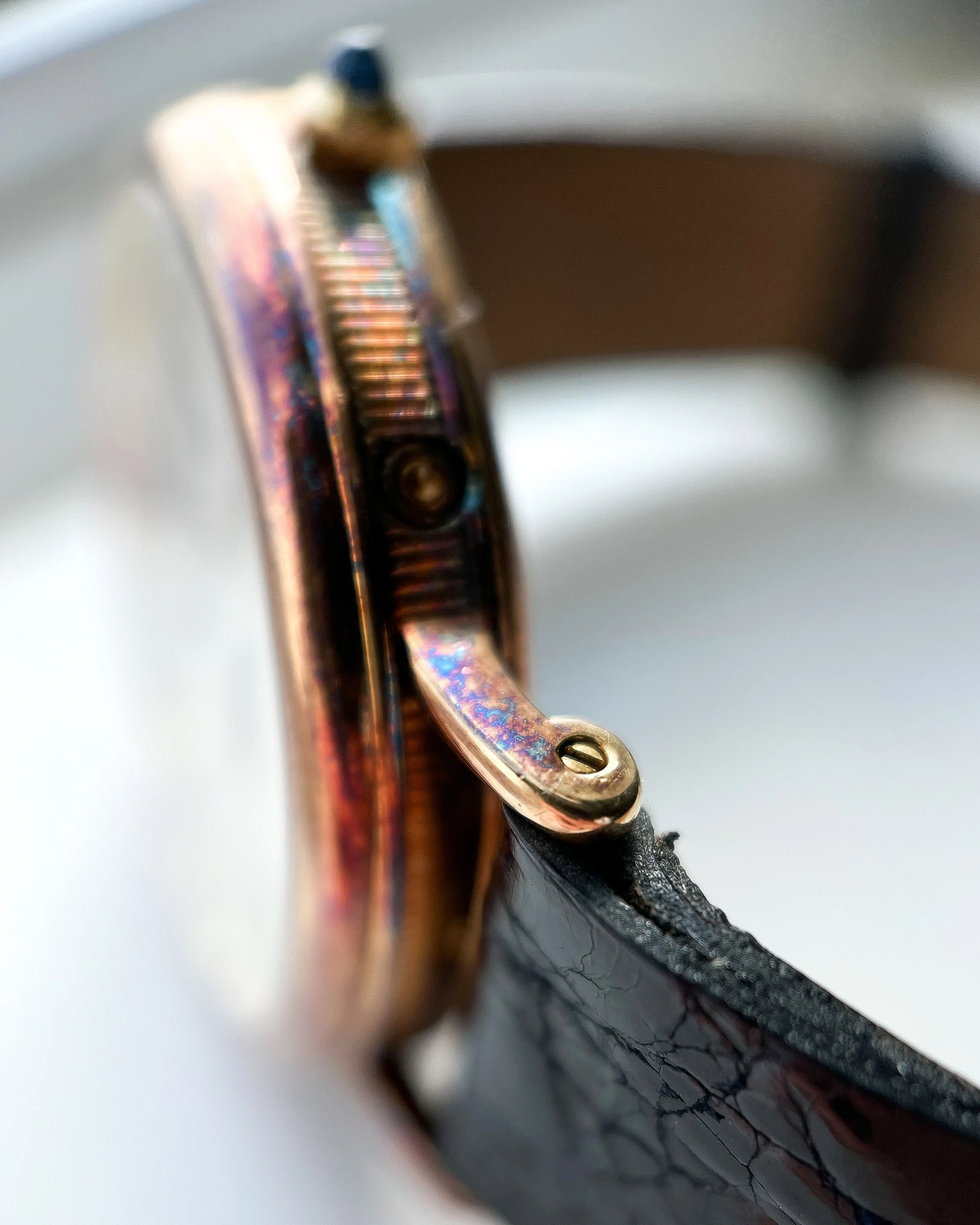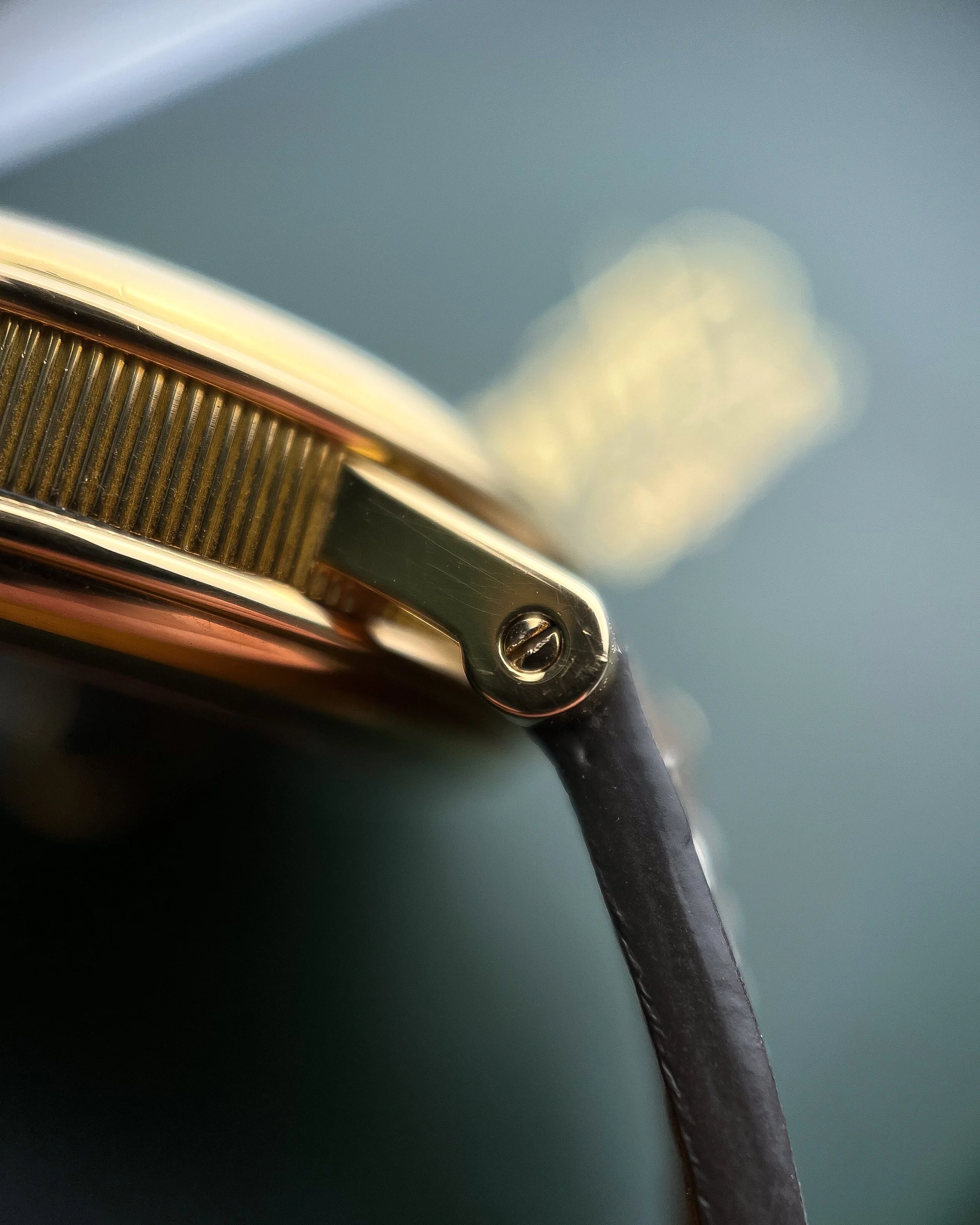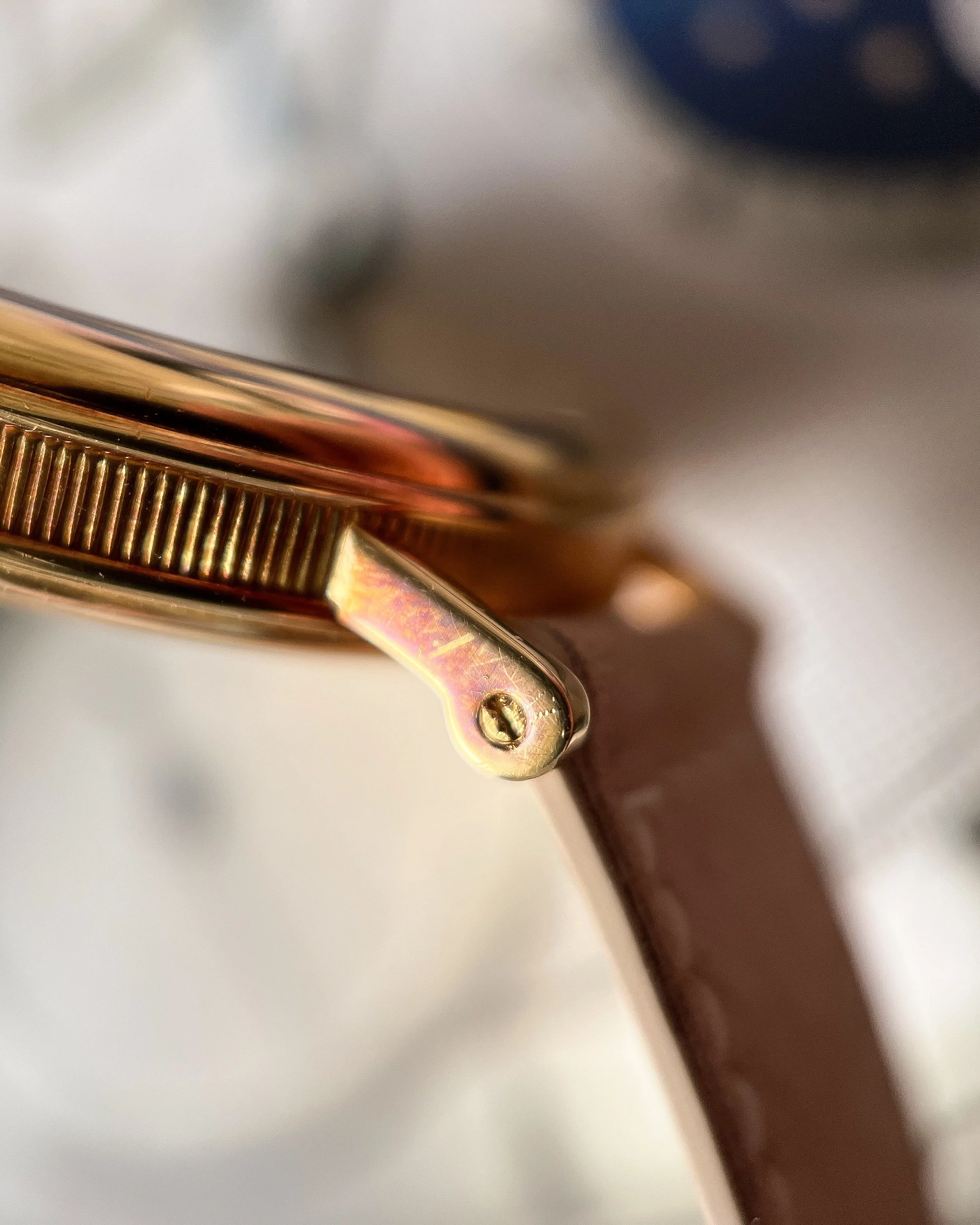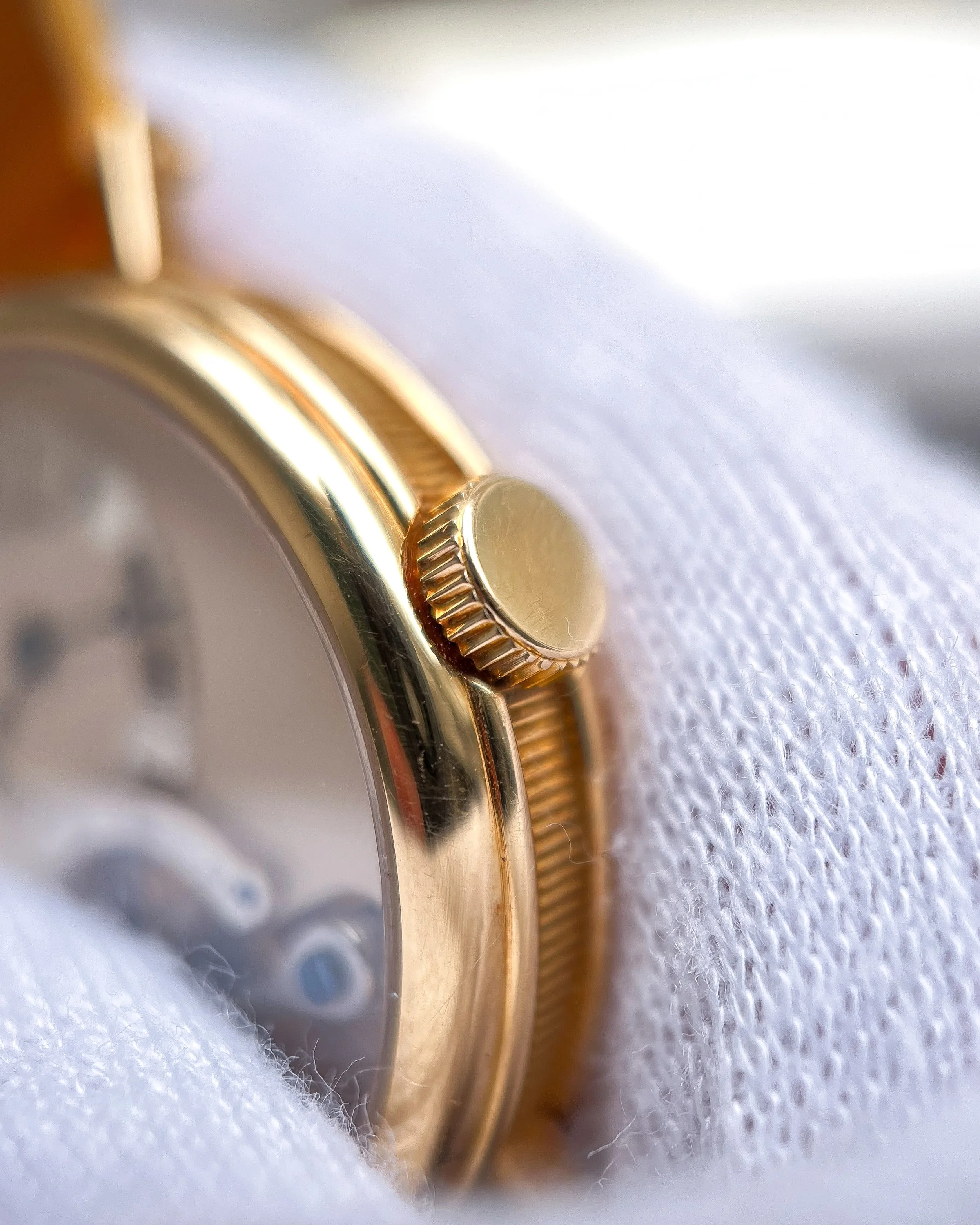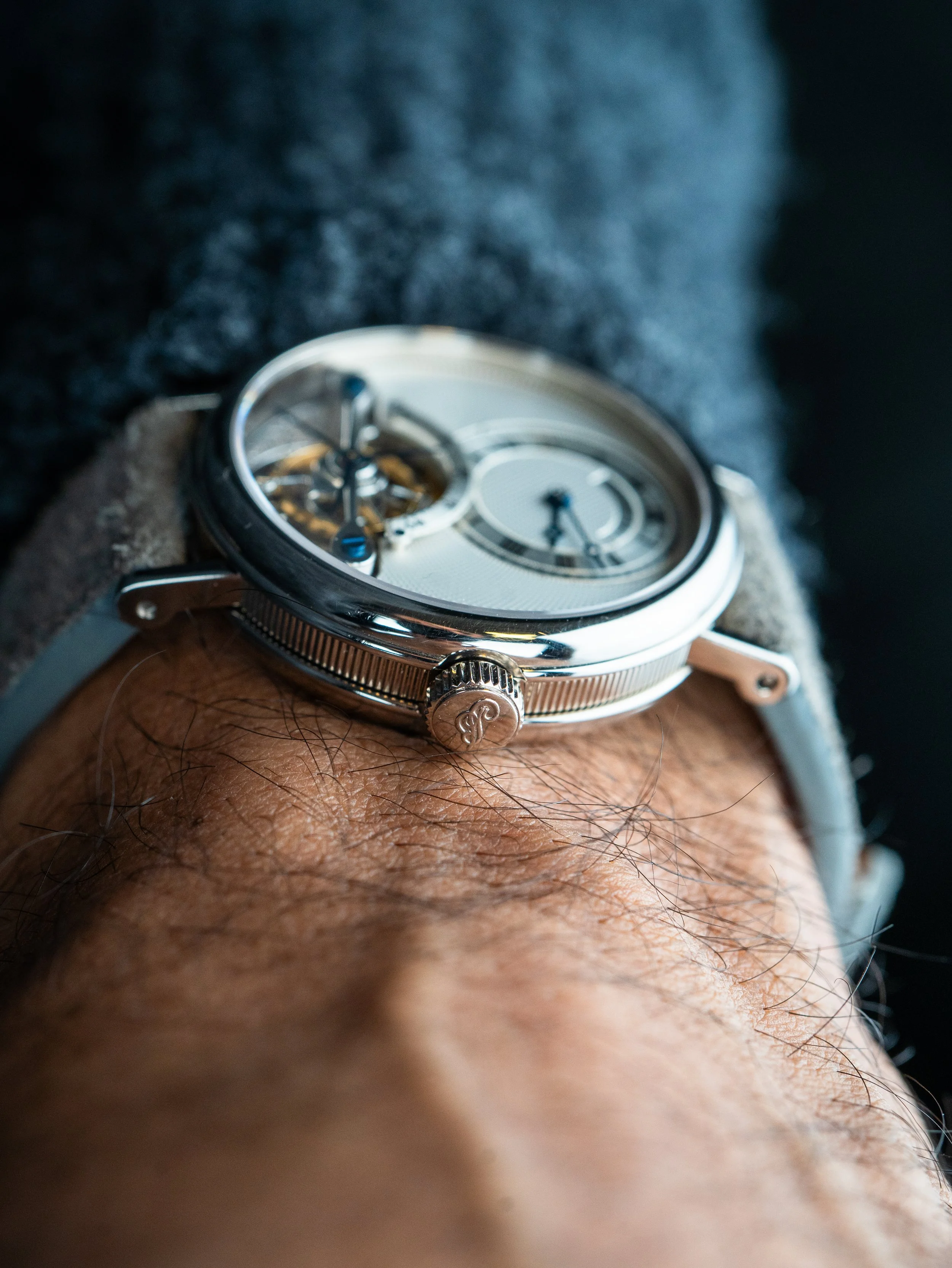A Collector’s guide to Roth era Breguet
Breguet’s history
Breguet is a brand with a rich heritage and historical importance. Let’s briefly touch upon Breguet's history and focus more on the important and beautiful references.
Year 1747, Great Abraham Louis Breguet was born in Neuchâtel.
Year 1775, Breguet was founded by A-L Breguet.
Year 1783, Order for the watch No. 160, the ‘Marie-Antoinette’ watch.
Year 1796, The sale of first Souscription watch.
Potrayal of Young A-L Breguet, Time and watches
Breguet’s inventions have changed and benefited the entire watch industry. Some inventions during A-L Breguet’s period include the first automatic watch, the iconic Breguet numerals and hands, the first use of guilloché in watchmaking, the 'pare-chute' shock absorber, the 'Breguet balance-spring,' and so on.
Year 1801, The invention of Tourbillon, a completely new regulator, revolutionary and ground breaking.
Year 1810, First watch designed to be worn on the wrist.
Year 1812, Introduction of the first off centered dials.
Year 1823, Death of A-L Breguet, His son Antoine-Louis Breguet takes over the brand.
Year 1830, Invention of the first watch with keyless winding mechanism.
Year 1933, Opening of the Place Vêndome Boutique.
Year 1954, Mass production of the type XX chronos.
Year 1970, Sale of breguet to Chaumet Brothers.
Year 1987, Acquisition of Breguet by Investcorp.
Year 1999, Sale of Breguet to the Swatch group.
Daniel Roth
Year 1975, Daniel Roth joins Breguet.
Year 1988, Daniel Roth leaves Breguet to pursue independent watchmaking.
In 1975, Daniel Roth joined Breguet, then owned by the Chaumet brothers, at the request of François Bodet. Roth was tasked with leading the brand and restoring its former glory. Looking back, it's clear that Roth succeeded magnificently in putting Breguet back on the map. Prior to Roth's arrival, from 1970 to 1975, Breguet had been in a steep decline. During his time at the helm, Roth was responsible for many iconic watches that not only elevated Breguet's reputation in the world of horology but also contributed to its commercial success. In fact, many of these references, with only slight modifications, are still part of Breguet’s catalog today. As such, the 'Roth era' is widely regarded as the most significant period for Breguet since the time of A-L Breguet. The pieces from this era are not only the most collectible but, in our humble opinion, some of the finest ever made. While we won’t dive into Roth’s career outside of Breguet today, our focus will be on the key pieces from his time at the brand, their unique characteristics, reference numbers, and more.
Humble Beginnings - 3040, 3050
Ref. 3040
The Breguet Ref. 3040 is one of the earliest references from the brand during the Chaumet era, released as part of Breguet’s relaunch in the early '70s. It earned the nickname 'Serpentine' due to its distinctive, wavy, snake-like date hand. The watch features a classic 36mm signature coin-edge case, with lugs that are meticulously hand-welded and hand-finished, showcasing Breguet’s exceptional craftsmanship.
The dial is adorned with intricate hand-made guilloché decoration, a hallmark of the brand’s dedication to artistry. This timepiece is equipped with a triple calendar complication, complete with a moonphase. The day and month are displayed through apertures at 12 o'clock, while the date is indicated by the central serpentine hand, creating a unique and visually captivating dial layout that stands out as both functional and elegant.
Ref. 3050
The Breguet Ref. 3050 Perpetual Calendar is one of Daniel Roth’s first major contributions to the brand. Introduced in 1976, it was developed by Roth alongside Louis-Maurice Caillet during a time when perpetual calendars were almost nonexistent. The very important QPs from the likes of AP, VC, Patek were still under development when the 3050 was launched. This reference holds a special place in Breguet’s history, with François Bodet, the general manager at the time, reflecting on it with great pride.
“This is how Breguet launched the fashion for complicated watches,” he said.
The 3050 features the signature 36mm coin-edge case and measures just under 8mm in height, embodying elegance in its purest form. Creating these watches was no small feat. François Bodet once noted that only 2 or 3 perpetual calendars left Breguet’s doors each year, as the intricate process required the expertise of around thirty distinct watchmaking professions to craft a single timepiece. While the exact period and references for these production numbers remain unclear, it offers a glimpse into the rarity and exclusivity of these exceptional watches.
The design of the 3050 was derived from a perpetual calendar pocket watch that Roth made while studying at Le Sentier, which was later sold under the Breguet name to reimburse Chaumet’s investment and expenses for his education early on.
The Core - 3130, 3230, 3330
Ref. 3130
An early 3130 with an open caseback that we had the pleasure of selling recently, Tahoma Watches
The Breguet Ref. 3130 is one of the brand’s most iconic and significant timepieces. Released in the early '80s, this reference quickly became the quintessential Breguet. Its distinctive dial features a sectorial power reserve, a moonphase display positioned between 1 and 2 o'clock, and the day of the month displayed on a sub-dial at 6 o'clock. This unique layout is instantly recognizable, even from a distance, making it impossible to confuse with any other watch. In fact, one of the hallmarks of Breguet’s collection is its unmistakable, distinctive design—each reference exudes a sense of individuality that is purely ‘Breguet.’
The ref. 3130 was inspired by the pocket watch no. 5, which was sold in 1794 — a design that remains relevant 250 years later!
Breguet watch no. 5, Italian Watch Spotter
The ref. 3130 is a huge milestone for the brand. Several references were based on the 3130, such as the Equation of Time (Ref. 3470), the Perpetual (Ref. 3310), etc. Quickly, the watch became the brand’s best-seller!
Ref. 3230/3237
The Breguet Ref. 3230, launched in the mid-'80s, is a two-register chronograph designed by Daniel Roth and powered by the renowned Lemania 2310 ébauche. This movement, famous for its reliability and precision, has been used by prestigious brands such as Patek Philippe, Roger Dubuis, and more. Breguet would later acquire Lemania in 1992. The caliber 2310 is not only a workhorse but also a beautifully crafted movement, with Breguet ensuring that each one was finished to the highest standards.
The 3230 also features the brand’s signature elements, including the classic guilloché dial, the iconic coin-edge case, and blued Breguet-style hands. As with many other Breguet references, it was available with both open and closed case backs, a feature we’ll delve into further later in the article.
Ref. 3330
An early 3330, we had the pleasure of selling recently.
Reference 3330, introduced in the early 1980s and affectionately nicknamed the "Chinoise," was designed by Roth. This watch features a combination of complications, including a day-date display and a moon phase indicator. The layout is particularly distinctive, with the moon phase at 12 o'clock, the date at 2 o'clock, and the day at 10 o'clock, while the time display is subtly off-center toward the bottom of the dial. At 36mm, the design feels both charming and refreshing, offering a delightful visual balance. In its time, it was arguably the most captivating and interesting piece in Breguet’s catalog. Even 250 years later, the design continues to feel remarkably fresh and intriguing.
Breguet watch no. 4579
It was inspired by one of the early pocket watches, namely No. 4579, which was created by A-L Breguet. It was the world’s first watch to feature an off-centered dial layout. The 4579 was also a ‘montre à tact,’ meaning the wearer could read the time without viewing the watch, simply by touching it.
The Last Dance - 3310, 3350
Ref. 3310
Introduced in 1986 and produced until the 2000s, the Ref. 3310 was Daniel Roth’s second foray into the world of perpetual calendars. If you're drawn to distinctive, eye-catching layouts, this one stands out. Drawing inspiration from the 3130, the 3310 is a masterful blend of complexity and elegance, featuring all the essential perpetual calendar complications, along with a power reserve indicator. While many interesting perpetual calendar designs have come and gone, few manage to capture the intrigue and charm of the 3310’s layout. What truly sets this piece apart, however, is its dial—a stunning canvas of guilloché patterns, each sub-dial showcasing an intricate design, making the 3310 not only a functional timepiece but a visual work of art.
A very early perpetual calendar 3310 we had the pleasure of selling recently.
The 3310 was a completely fresh approach to the perpetual calendar layout, breaking the stereotypes of traditional 3 or 4-register perpetuals.
Ref. 3350
The Breguet Ref. 3350 Tourbillon stands as the pinnacle of Daniel Roth's work during his time with the brand—a masterpiece that remains one of his most iconic creations. While A.-L. Breguet is credited with inventing the tourbillon, it was Roth who perfected it. The Ref. 3350 features a one-minute tourbillon, the result of a three-year collaboration between Roth and Nouvelle Lemania. This partnership led to the development of the Caliber 558, which is widely regarded as one of the most beautiful tourbillon movements ever crafted. Roth was so enamored with the design that he used the same ébauche for his own tourbillon models.
The Ref. 3350 is nothing short of a work of art. Its dial presents an off-center time display, a 20-second counter, and the tourbillon cage with three hands, each hand passing the 20-second mark once per minute, indicating the seconds. The dial also showcases exquisite handmade guilloché patterns—just a hint of the craftsmanship Breguet is renowned for. The large cut-out at 6 o'clock offers a clear view of the skeletonized tourbillon cage, which is finely finished, hand-engraved, and adorned with heat-blued screws and hands. Every detail of this watch exudes perfection, beauty, and unparalleled craftsmanship.
Decoding the reference numbers
Breguet references are mostly in the format as shown below, Note: This is a general guide that was put by observation and not an official guide from the brand. This is also valid for most Breguet even post 90s and nothing specific to Roth era.
| XXX Y AB / | CD / | EFG |
| Model Special features Case Metal | Dial | Band |
| Case | Dial | Bracelet/band |
For example XXX Y AB/CD/EFG - 3137BA/11/986(Actual)
The first 3 digits(XXX) in the serial number collectively represent the watch group.
The first digit is odd for men’s watches (or unisex), and even for ladies' watches.
The next two digits are loosely used for a watch model
The Fourth digit(Y) represents special features as shown below and AB indicates the case metal
The Fourth digit ‘Y’ represents special features
0 - Closed caseback / Open case back (More on this later in the article)
1 - Articulated dial cover
3 - Special version
5 - Open worked" full skeletonized dial
7 - Transparent case-back (even partial)
8 - Diamonds bezel or cover + diamonds on lugs and sometimes case
9 - Pavé diamond dial + diamond bezel, lugs, case
‘AB’ indicates the case metal
AG - Silver
BA - Yellow Gold
BB - White Gold
BR - Rose gold
PR - Platinum and rose
PT - Platinum
ST - Stainless
TI - Titanium
CD represents Dial
00 - No dial (skeleton)
11, 12, 1E or 15 - Silver coated gold guillloché
29 - White enamel
2P - Red Enamel
2Y - Blue enamel
32 - Rose gold Guilloche
51 - Mother of pearl
59 - Blue Mother of pearl
5D - Mother of pearl with diamonds
5T - Tahiti mother of pearl
8D - Mother of pearl and precious stones
The final group of the serial (EFG) represents the bracelet / band of the watch
The second digit F represents lug, case size
6 - lug width unknown - 30 mm case
8 - 18mm lug - 35/36 mm case
9 - lug width unknown - 40x34 mm case
A - 18 mm lug - 36mm case
V - 20 mm lug 37, 38, 39, 40 mm case
W - 21 mm lug - 39, 40 mm case
X - lug width unknown - 44, 44.5 mm case
Y - lug width unknown - 48 mm case
Z (and M) - lug width unknown - 41, 42, 43, 44, 45 mm case
The first digit (E) represents band material
2 - Alligator/croc
3 - Calf leather
5 - Rubber
8 - Satin
9 - Crocodile leather
A- Metal bracelet in yellow gold
B - Metal bracelet in white gold
R - Metal bracelet in rose gold
P - Metal bracelet in platinum
S - Metal bracelet in stainess steel
T - Metal bracelet in titanium
Information on the last digit G is unknown.
So, ref. 3137BA/11/986 decodes to
A unisex/men’s watch
open case back
silver coated guilloche dial
36mm size, alligator strap
Collecting Nuances
What is PRE-A?
When we first began collecting Breguet, one of the most common—and most intriguing—questions we encountered was, "What exactly is PRE-A?" The term "PRE-A" was popularized by the passionate watch collector and enthusiast, André K. But what does it really mean? "PRE-A," also known as "PRE-SERIES" or "PRE-1987," refers to watches produced before Breguet introduced serial numbers ending in letters—A, B, C, D, and so on—that indicated a chronological sequence.
So why does this period hold such significance? The introduction of these alphabetic serial numbers came in the late '80s, around 1987/88, right after Breguet was sold to Investcorp and Daniel Roth departed from the brand. Therefore, "PRE-A" watches were made during Roth's time at Breguet, making them not only historically significant but also highly collectible and desirable among enthusiasts.
No. 5123, PRE-A
No. 3581 A, A series
No. 1139 E, E series
While most late ‘PRE-A’ models from the late '80s and the early A, B, C, D, and E series share similar characteristics in terms of dial, case, crown, and calibers, the very early ‘PRE-A’ pieces from the early '80s stand out due to some distinct differences. These early examples feature unique details, such as smooth case backs and dials that lack the "SWISS" marking, rounded lugs setting them apart from later models. As a result, these early ‘PRE-A’ watches are considered even more collectible and highly sought after by enthusiasts.
Open/closed casebacks and differences in references
There’s a big discussion and ambiguity around this topic, mainly regarding reference numbers. Often, we see 3xx0 references with both open and closed case backs. However, references like 3xx7 were only available with open case backs. So, what’s the catch?
Until the late 80s/early 90s, there were no 3xx7 references in Breguet’s catalog.
The early 3xx0 references had both open and closed case back variants, and they were sold under the same reference.
Standard closed case backs were sold under the reference 3xx0, while open case backs were referred to as 3xx0 ‘avec fond transparent’ (with transparent case back).
Later, Breguet began to introduce 3xx7 reference numbers during the Investcorp era. However, Breguet didn’t start inscribing reference numbers on the case backs until the late 90s (more on this in the next section).
Some specific models, like the Chronograph (3230), had 3xx7 reference numbers introduced as early as 1988/89. References 3237 and 3230 existed in Breguet’s catalog in the mid-90s. However, references like 3130, 3330, 3040, 3050, etc., didn’t have their respective separate 3xx7 references; they were still sold only as ref. 3xx0 for both open and closed case backs.
Since there were transitions from 3xx0 to 3xx7 references, dealers and even Breguet used them interchangeably when filling out warranty cards, marketing, etc.
Huge thanks to @meticulist @watchbrotherslondon for some of this research.
3230, close case back, ACM
3230 ‘avec fond transparent’ (open case back), WBLDN
3237, although ref number not inscribed on caseback. Meticulist
Case styles - Lugs, Case backs
Throughout Breguet's early years and into the 2000s, we've seen a variety of case back styles and lug designs. These include smooth case backs from the early models, rounded lugs, short and thick lugs, standard lugs, case backs without reference inscriptions, and those with reference inscriptions. To better illustrate these differences, let's take a closer look at each style with some pictures for added clarity.
Case back styles
Full smooth caseback, @lanaturaetutto
Full smooth caseback with one step
Caseback with ‘automatic’ and standard guilloche pattern.
Smooth caseback with Chaumet stock number, NLW by Charles-Hadrien Vinault
Display caseback, No ref number inscription, Keystone
Caseback with ‘automatic’ and standard guilloche pattern and ref number, Watchley
Display caseback, ref number inscribed, Hairspring
Lug styles
rounded lugs (found mostly on early but also sometimes on later examples)
Short-thick straight lugs
Long straight lugs
Dial Variations
There are numerous dial variations and nuances, many of which are specific to individual references. We’ll dive deeper into these details in upcoming articles dedicated to each reference (stay tuned!). Many models feature multiple dial variants, including different fonts, ‘SWISS’ markings, secret signatures, and more.
However, let’s focus on one key aspect: Early dials typically featured the ‘SWISS’ marking, while later dials—primarily from the late '90s onward, after the Swatch acquisition—displayed ‘SWISS GUILLOCHE MAIN.’
It’s important to note that some references, like the 3310, never included either of these markings.
Additionally, some very early dials did not feature the ‘SWISS’ marking at all.
Early dial, 1982, No ‘SWISS’ very rare. Ref. 3330
‘SWISS’ dial, Ref. 3330
‘SWISS GUILLOCHE MAIN’ Dial, Ref.3330 Tickingtimehomme
Secret Signatures were absent on early models but were later introduced as a distinct feature. However, some references, such as the 3310, never featured a Secret Signature on the dial.
3137 with secret signature (late production), Corrado Mattarelli
Early 3137, No secret signature
Crown styles
There were three crown styles observed from the 70s through the 2000s
Flat crown with no ‘B’ logo
These were seen on very early examples, some refs like 3230 featured only these crowns.
Cabochon crown
These were also present on some early ones(rarely) but mostly in the later stages from mid 80s through late 90s
Also, all examples that have been sold to Italy did not have Cabochon crowns.
Some specific refs like 3350, 3230 never came with cabochon crowns either.
Flat crown with ‘B’ logo
These can be seen on mostly modern examples from late 90s to present.
Closing Thoughts
The Roth era at Breguet represents the pinnacle of the brand’s legacy, following in the footsteps of A-L Breguet. Technically exceptional, aesthetically stunning, and impeccably crafted, watches from this period are not only highly collectible but also incredibly rare. In our opinion, every serious watch collection should include at least one reference from this iconic era!
Fun fact: In 1983, Breguet's total sales were just 500 watches across all references—making those early pieces extraordinarily scarce. By 1987, sales had more than doubled to 1,200 units. Fast forward to 2021, and Breguet's sales skyrocketed to an impressive 18,000 units, illustrating just how far the brand has come since Roth's time.
Get in touch!
This article is based entirely on research and observations found on the internet and from our friends and is not officially provided by Breguet. It is a continuous work in progress and will be updated as we find more information. We would also love to hear your thoughts, suggestions, or if you would like to contribute!
Instagram
Whatsapp
Email
Credits
None of this would have been possible without the help of the watch community. Huge thanks to @watchbrotherslondon, @meticulist, @andre, @phillipswatches, @apexluxuryuk, @alfredoparamico, @watchesbylogan, @fred_le_blanc, @breizhouben, @hairspringwatches @italianwatchspotter @quillandpad and many more. Also a lot of information was obtained from books, auction catalogs and forums.
Credit to Don-Indiano for the some ref guide decoding information.
Special Thanks to our dear friend Ben, @watchbrotherslondon for providing much of the valuable information and bringing many of these important pieces to the market.


